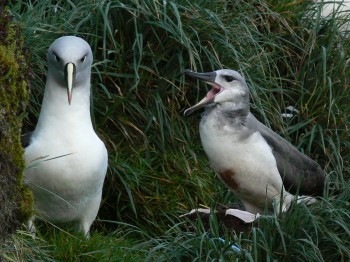Claude Joiris and Olivier Dochy (Laboratory for Polar Ecology, Ramillies, Belgium) write in the journal Polar Biology on discovering an important foraging area for Grey-headed Albatrosses Thalassarche chrysostoma around the South Shetland Islands.
The paper’s abstract follows:
“The main aim of our long-term study on the at sea distribution of the upper trophic levels in polar marine ecosystems is to deepen the understanding of the basic mechanisms affecting their distribution, i.e. hydrological factors such as water masses and fronts, pack ice and ice edge, eddies. A second goal consists in detecting spatial and temporal changes, with special attention to global climate changes, as well as possible consequences of (krill) fisheries. Seabirds and marine mammals were recorded during an autumn expedition of ice breaking RV Polarstern between Punta Arenas and the South Shetland Islands, Antarctica in March/ April 2012. During a total of 333 half-an-hour transect counts without width limitation, 113,500 seabirds were encountered, belonging to 40 species. The vast majority were southern fulmars and grey-headed albatross around the South Shetland Islands, with 76,800 and 7,000 individuals, respectively. Fin whale was by far the most abundant cetacean with 300 identified individuals in the same area, of which 100 in one count. These exceptional concentrations of fin whale seem to reflect an autumn pre-migration feeding aggregation. For most species, the majority was concentrated in very few counts, reflecting a very high patchiness and, as upper trophic levels, an important prey availability—mainly krill, nekton and small fish. Low biodiversity was reflected by both the low number of species and the fact that a few species represent the vast majority in numbers. It is suggested that the area deserves future biological studies, especially in autumn, and a special protection management.”

A Grey-headed Albatross chick begs for food, photographed by Marienne de Villiers
Reference:
Joiris, C. & Dochy, O. 2013. A major autumn feeding ground for fin whales, southern fulmars and grey-headed albatrosses around the South Shetland Islands, Antarctica. Polar Biology DOI 10.1007/s00300-013-1383-8.
John Cooper, ACAP Information Officer, 5 September 2013

 English
English  Français
Français  Español
Español